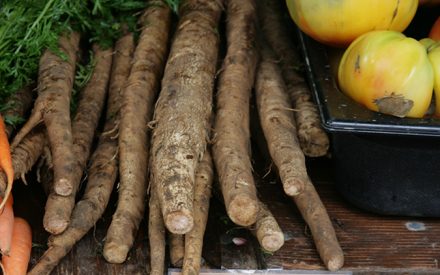In this video, Steph Plaster, Extension Farm Management Outreach Specialist, goes over business models and a tool called the business model canvas which can help you solidify your food or farm business idea and help you describe the value your product or service will bring. Defining your business model can help you connect and communicate with partners and funders. It is a good reality check on your business idea before you pour money into a model that might not be able to achieve your vision and goals.
Transcript
Hello, I am Steph Plaster, Farm Management Outreach Specialist with the UW-Madison Division of Extension. In this video, I will be going over business models and a tool called the business model canvas which can help you solidify your food or farm business idea and help you describe the value your product or service will bring.
The takeaways of this video are: What is a business model? How can you use the business model canvas to flesh out your business idea? And how do you explain the value that you bring?
The business model is a description of how your business runs or, put another way, a framework for how your business operates. It describes your plan to capture value, make a profit, meet a need and make money. It can also be a first crack at explaining your competitive strategy. Defining your business model can help you connect and communicate with partners and funders. It is a good reality check on your business idea before you pour money into a model that might not be able to achieve your vision and goals.
This video focuses on a tool called the Business Model Canvas to help you sketch out your idea on paper. One of the creators of the business model canvas states, “A business model describes the rationale of how an organization creates, delivers and captures value”. Being able to understand and define the value of your food or farm business can help you make stronger business decisions and create pathways to success.
How do you refine or evaluate this business idea? The Business Model Canvas is a one page tool that asks you to answer nine key questions any successful business should be able to. We’ll go through these now.
The key thing we want to do especially in the beginning is be able to explain why your business should exist and what value it brings to its potential customers. Do you have your elevator pitch ready to go? Could you explain it to someone? This will help get you there.
On the screen, you’ll see the one-page business model canvas. The nine boxes contain the key areas you will need to define to to solidify your business model. Those areas are the value proposition, key partners, key activities, key resources, customer relations, channels, market segments cost structure and revenue streams. We will go through these sections briefly next. If you need additional help and prompts to fill out these boxes we have a worksheet available which will be linked below and can be found on our Extension Farm Management website.
The left side of the canvas is the supply side. These boxes ask you to identify key partners key activities and key resources. These are the internal needs of the organization that will enable the business to deliver on the customer’s needs.
In the upper right part of the canvas is the demand side. Customer segments, customer relations and distribution channels are focused on the customer’s needs, wants and desires and how you wish to interact with your customers. How are you going to maintain those relationships? The more you can define these the better positioned you will be?
Arguably, the most important box is the value proposition. Here you are asked what value you bring by defining what problem your product or service is solving for a customer? Or why would they spend their hard-earned money on your product?
If value is hard for you to wrap your head around, a definition of value may help. Values are the quality of being useful or important, a degree of excellence, a sense of worth, or something considered or rated highly. Rephrased in question form: Why is your product useful or important? What degree of excellence or distinguishing attribute with your product provides the customer to benefit them? What will your product or business be known for or the best at?
The bottom two sections describe cost structures or what expenses you will have. How much will it cost to operate, and the potential paths to revenue or what will make you money? Remember, if you need additional help and prompts to fill out these boxes, we have a worksheet available which will be linked below and can be found on our Extension Farm Management website.
We’ve defined our business model. How do we know this business model will work? This is where it really pays to ask people, especially those who you have identified as potential customers. We will cover the Lean Startup method in a later video, but briefly, it is a lower-cost way to test your assumptions about the products customers desire and the price they are willing to pay for them. You ask potential customers if they would be interested in your product and listen to their responses. If it does not sound like folks would be interested, adjust the product pricing or customer base and retest. Repeat until your model is proven or you seem to generate genuine interest and excitement.
If you find yourself not able to answer the questions if you are not confident in your answers, there are options for support to help you. UW Madison Division of Extension, the Small Business Development Centers, Food Finance Institute, SCORE, Wisconsin Economic Development Corporation, or local economic development corporations and other organizations or consultancy firms can help flesh out these ideas and answers. You may just need someone to bounce ideas off of and that’s okay.
That’s it for this video. I hope the Business Model Canvas is a useful tool to help you flesh out that business idea. Please visit our Extension Farm Management website at farms.extension.wisc.edu to find additional resources to help you start your food or farm business. We have articles and worksheets available to help you develop that business model canvas. The link to those resources can be found below. Feel free to reach out to our program with questions, and thanks for watching.


 Organic Transition: Purpose, Process, and Resources
Organic Transition: Purpose, Process, and Resources Partnerships for Your Food or Farm Business
Partnerships for Your Food or Farm Business Finding the right people
Finding the right people Permits, licenses, and labels
Permits, licenses, and labels


